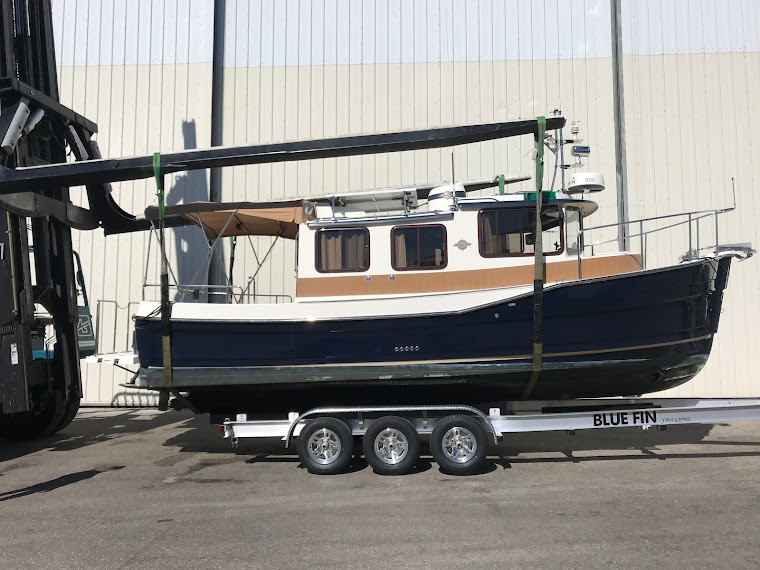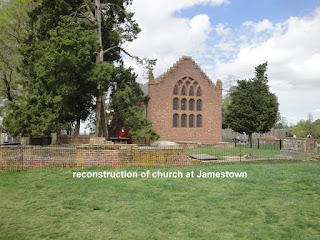Walking the path of the Revolutionary
War
A golden day – I purchased for $10 my
Golden Pass to our National Parks – it gets me and three friends in for my
lifetime! Our tax dollars at work. Steve and I used the pass to tour the
Jamestown historic site and the Yorktown battlefield. We spent the day revisiting the Revolutionary
War era. We started with an archeologist who explained the tragedies of
Jamestown and the courage which was needed to establish that first English
settlement in what became the United States. The site is on the James River
across the peninsula from Yorktown (on the York River where we moored.)
However, unlike the hills and cliffs in Yorktown, Jamestown was founded on an
island that is essentially a swamp. The location, however, was optimal from a
military perspective. Ships approaching were vulnerable so the site was easy to
defend from attacks by sea. The enemies
were not all Spanish warships as it turned out. Powhatan Indians strongly objected
to the English living in their hunting grounds. (They did not choose to live
there due to the absence of drinking water, another slight drawback.) In fact,
we learned that the water problem probably was more serious than previously
thought since it is now clear from the study of burial sites that the settlers
were drinking the river water which was brackish containing too much salt for
good health. The wells also were unsafe
with high levels of arsenic caused by the surrounding swamp water leaching into
the ground water. Recent research from the study of giant Cypress stumps in the
Great Dismal Swamp have shown that the settlement was founded at the beginning
of a period of severe drought which lasted for more than 7 years further
compounding all these water issues. In addition, the prevalence of diseases
like typhoid fever and dysentery added to the hardships endured by early
settlers. It is truly amazing that these settlers managed to make peace with the
Indians and find viable cash crops so they could survive. But survive and
thrive they did making the first English laws in the Jamestown church and peace with the Indians including the marriage of Pocahontas to John Rolfe. The
precise location of the first fort built in 1607 has been determined and
research continues to identify the remains buried on the historic site as well
as discover structures which were part of the settlement. Standing on the bank
of the James River on a balmy spring day it is easy to see why those first
settlers thought this might be a great spot to build a new world when they
arrived in early May 1607. However, the
weather in summer is much hotter and filled with bugs while winter can be harsh
and frozen. To understand their suffering we will have to return when the
weather is not as perfect as we enjoyed during our visit.
The Colonial Parkway connects the
major sites in the historical triangle of Virginia. We took a FREE national
park service shuttle bus from the visitor center in Yorktown to Colonial
Williamsburg and then another to Jamestown and back the same way. We made excellent connections each way since
the traffic was light – on both the leg out of Yorktown and back we were the
only passengers. This entire 30+ miles of road is a national park. There are
no, as in NO, ZERO, ZILCH businesses along the way. This route was laid out in
the 1930s but not completed until after WWII. The bridges are all carefully
constructed to depict the period in attractive red brick. Flowering dogwood,
red bud and assorted flowers have been planted to enhance the beautiful views of both the York and James rivers,
tributaries and marshes. I had expected
an hour of city driving, but this route was almost as relaxing as a cruise on
Erben Renewal. We ended our day with a film and tour of the battlefield where
the last major battle of the revolutionary war was fought - the siege of Yorktown. As with any visit to a place where many have
died, there is a profound sense that we owe those who sacrificed a debt which
it is important not to forget. Yet, gazing out over the wide green fields on
this glorious spring day with trees in bloom, leaves bursting out and gentle
breezes it was hard to believe the cannons we saw had ever fired and broken the
peace of this spot. We were encouraged to see the monuments to the historical
significance of these locations and the crowds of people who visited to keep
these lessons of history alive. Walking the streets of Yorktown is indeed a
walk back to our country’s earliest days. I am grateful such places have been
and are being preserved. The history lesson continues as we journey toward the
Potomac and Washington, DC.
We ended our day with a film and tour of the battlefield where
the last major battle of the revolutionary war was fought - the siege of Yorktown. As with any visit to a place where many have
died, there is a profound sense that we owe those who sacrificed a debt which
it is important not to forget. Yet, gazing out over the wide green fields on
this glorious spring day with trees in bloom, leaves bursting out and gentle
breezes it was hard to believe the cannons we saw had ever fired and broken the
peace of this spot. We were encouraged to see the monuments to the historical
significance of these locations and the crowds of people who visited to keep
these lessons of history alive. Walking the streets of Yorktown is indeed a
walk back to our country’s earliest days. I am grateful such places have been
and are being preserved. The history lesson continues as we journey toward the
Potomac and Washington, DC.
In the Yorktown Watermen Museum
quiet Yorktown streets

























That looked like fun. Joy- Proud Lady Litton Trawler
ReplyDelete